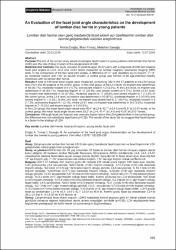| dc.contributor.author | Eroğlu, Ahmet | |
| dc.contributor.author | Yılmaz, İlhan | |
| dc.contributor.author | Eseoğlu, Metehan | |
| dc.date.accessioned | 2021-01-19T10:44:54Z | |
| dc.date.available | 2021-01-19T10:44:54Z | |
| dc.date.issued | 2018 | en_US |
| dc.identifier.citation | Eroğlu, A., Yılmaz, İ. ve Eseoğlu, M. (2018). An evaluation of the facet joint angle characteristics on the development of lumbar disc hernia in young patients. Pamukkale Medical Journal, 11(3), 229-235. https://doi.org/10.31362/patd.408161 | en_US |
| dc.identifier.issn | 1309-9833 | |
| dc.identifier.issn | 1308-0865 | |
| dc.identifier.uri | https://doi.org/10.31362/patd.408161 | |
| dc.identifier.uri | https://hdl.handle.net/20.500.12511/6295 | |
| dc.description.abstract | Purpose:The aim of the current study was to investigate facet tropism in young patients with lumbar disc hernia (LDH) and the role of facet tropism in the development of LDH Materials and methods:The study included 57 patients aged 20-32 years with a diagnosis of LDH and bilateral facet joint angles at L3-4, L4-5 and L5-S1 levels measured on lumbar magnetic resonance imaging (MRI) tests. In the comparison of the two facet joint angles, a difference of <7° was classified as no tropism, 7°-14° as moderate tropism and >14° as severe tropism. A control group was formed of 46 age-matched healthy individuals with no lumbar disc hernia. Results:A total of 618 facet facet angles were measured, comprising 342 in the 57 patients in the LDH group and 276 in the 46 subjects of the control group. In the LDH group, at the L3-4 level, no tropism was determined in 46 (80.7%), moderate tropism in 9 (15.7%) and severe tropism in 2 (3.5%). At the L4-5 level, no tropism was determined in 36 (63.1%), moderate tropism in 17 (29.8%) and severe tropism in 4 (7%). At the L5-S1 level, no tropism was determined in 33 (57.9%), moderate tropism in 17 (29.8%) and severe tropism in 7 (12.2%).In the control group, at the L3-4 level, no tropism was determined in 40 (87%), moderate tropism in 5 (10.9%) and severe tropism in 1 (2.2%). At the L4-5 level, no tropism was determined in 37 (80.4%), moderate tropism in 8 (17.3%) and severe tropism in 1 (2.1%). At the L5-S1 level, no tropism was determined in 34 (73.9%), moderate tropism in 7 (15.2%) and severe tropism in 5 (10.9%). In the LDH group, the mean facet angle values were 40.4° at L3-4, 42.7° at L4-5 and 45.9° at L5-S1 levels. In the control group, the mean facet angle values were 39.2° at L3-4, 41.4° at L4-5 and 43.9° at L5-S1 levels. Conclusion: Although facet joint tropism was seen at a higher rate in the LDH patients than in the control group, the difference was not statistically significant (p>0.05). The results of the study did not suggest that facet tropism is a factor in the etiology of LDH. | en_US |
| dc.description.abstract | Amaç: Çalışmamızda lomber disk hernisi (LDH) olan genç hastalarda faset tropizmini ve faset tropizminin LDH gelişimindeki rolünü araştırmak amaçlanmıştır. Gereç ve yöntem:LDH’si olan 20- 32 yaş arasındaki 57 hasta ile lomber disk hernisi olmayan sağlam olarak kabul ettiğimiz 46 hastanın lomber Manyetik Rezonans Görüntüleme (MRG) tetkiklerinde L3-4, L4-5, L5-S1 mesafesinde bilateral faset eklem açıları aksiyal planda ölçüldü. Karşılıklı her iki faset eklem açısı arasında fark <7° ise tropizm yok, 7°-14° arasında ise orta derece tropizm, >14° ise ağır tropizm olarak sınıflandırıldı. Bulgular:LDH’li 57 hastada 342, kontrol grubu 46 hastada 276 olmak üzere toplam 618 faset açısı ölçüldü. LDH grubununda L3-4 seviyesinde, %80.7’sinde (n=46) tropizm olmadığı, %15,7’sinde (n=9) orta derecede tropizm olduğu, %2’sinde (n=3.5) ağır derecede tropizm olduğu görüldü. L4-5 seviyesinde, % 63.1’inde (n=36) tropizm olmadığı, %29.8’inde (n=17) orta derecede tropizm olduğu, %7sinde (n=4) ağır derecede tropizm olduğu görüldü. L5-S1 seviyesinde %57.9’unda (n=33) tropizm olmadığı, %29.8’inde (n=17) orta derece tropizm olduğu, %12.2’sinde (n=7) ağır tropizm olduğu tespit edildi. Kontrol grubunda ise L3-4 seviyesinde, %87’sinde (n=40) tropizm olmadığı, %10.9’unda (n=5) orta derecede tropizm olduğu, %2.2’sinde (n=1) ağır tropizm olduğu tespit edildi. L4-5 seviyesinde, %80.4’ünde (n=37) tropizm olmadığı, %17.3’ünde (n=8) orta derecede tropizm olduğu, %2.1’inde (n=1) ağır tropizm olduğu görüldü. L5-S1 seviyesinde %73.9’unda (n=34) tropizm olmadığı, %15.2’sinde (n=7) orta derece tropizm olduğu, %10.9’unda (n=5) ağır tropizm olduğu tespit edildi. LDH’li grupta faset açı ortalamaları L3-4’te 40.4; L4-5’t; 42.7; L5-S1’de 45.9 idi. Kontrol grubu faset açı ortalamaları L3-4’te 39.2; L4-5’te 41.4; L5-S1’de 43.9 derece idi. Sonuç: Çalışmamızda faset eklem tropizmi, LDH’li hastalarda kontrol grubuna göre bir miktar yüksek oranda görülüyor olmasına rağmen istatistiksel olarak anlamı olmadığını belirledik (p>0.05). LDH etiyolojisinde faset tropizminin predispozan bir faktör olarak rol oynamadığını düşünmekteyiz. | en_US |
| dc.language.iso | eng | en_US |
| dc.publisher | Pamukkale University | en_US |
| dc.rights | info:eu-repo/semantics/openAccess | en_US |
| dc.subject | Lumbar Disk Hernia | en_US |
| dc.subject | Facet Joint Tropism | en_US |
| dc.subject | Young Adults | en_US |
| dc.subject | Facet Joint | en_US |
| dc.subject | Lomber Disk Hernisi | en_US |
| dc.subject | Faset Eklem Tropizmi | en_US |
| dc.subject | Genç Erişkin | en_US |
| dc.subject | Faset Eklem | en_US |
| dc.title | An evaluation of the facet joint angle characteristics on the development of lumbar disc hernia in young patients | en_US |
| dc.title.alternative | Lomber disk hernisi olan genç hastalarda faset eklem açı özelliklerinin lomber disk hernisi gelişimindeki rolünün araştırılması | en_US |
| dc.type | article | en_US |
| dc.relation.ispartof | Pamukkale Medical Journal | en_US |
| dc.department | İstanbul Medipol Üniversitesi, Tıp Fakültesi, Cerrahi Tıp Bilimleri Bölümü, Beyin ve Sinir Cerrahisi Ana Bilim Dalı | en_US |
| dc.authorid | 0000-0003-0260-1988 | en_US |
| dc.identifier.volume | 11 | en_US |
| dc.identifier.issue | 3 | en_US |
| dc.identifier.startpage | 229 | en_US |
| dc.identifier.endpage | 235 | en_US |
| dc.relation.publicationcategory | Makale - Ulusal Hakemli Dergi - Kurum Öğretim Elemanı | en_US |
| dc.identifier.doi | 10.31362/patd.408161 | en_US |


















